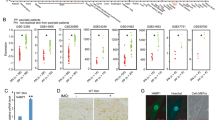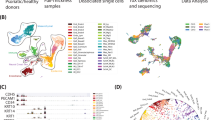Abstract
S100A7 (psoriasin) and S100A15 (koebnerisin) were first identified in inflamed psoriatic skin. They are of major interest because of their putative functional roles in innate immunity, epidermal cell maturation, and epithelial tumorigenesis. Human S100A7 and S100A15 have lately evolved by gene duplications within the epidermal differentiation complex (chromosome 1q21) during primate evolution forming a novel S100 subfamily. Therefore, S100A7 and S100A15 are almost identical in sequence (>90%) and are difficult to discriminate. Despite their high homology, S100A7 and S100A15 are distinct in tissue distribution, regulation, and function, and thus, exemplary for the diversity within the S100 family. Their different properties are compelling reasons to discriminate S100A7 (psoriasin) and S100A15 (koebnerisin) in epithelial homeostasis, inflammation, and cancer.




Similar content being viewed by others
Abbreviations
- UTR:
-
Untranslated region
- EDC:
-
Epidermal differentiation complex
- S100A15-L:
-
Long human S100A15 transcript
- S100A15-S:
-
Short human S100A15 transcript
- TLR:
-
Toll-like receptor
- RAGE:
-
Receptor of advanced glycated end products
References
Abtin A, Eckhart L, Mildner M, Gruber F, Schroder JM et al (2008) Flagellin is the principal inducer of the antimicrobial peptide S100A7c (psoriasin) in human epidermal keratinocytes exposed to Escherichia coli. FASEB J 22(7):2168–2176
Alowami S, Qing G, Emberley E, Snell L, Watson PH (2003) Psoriasin (S100A7) expression is altered during skin tumorigenesis. BMC Dermatol 3:1
Bianchi R, Giambanco I, Arcuri C, Donato R (2003) Subcellular localization of S100A11 (S100C) in LLC-PK1 renal cells: calcium- and protein kinase c-dependent association of S100A11 with S100B and vimentin intermediate filaments. Microsc Res Tech 60(6):639–651
Bierhaus A, Humpert PM, Morcos M, Wendt T, Chavakis T et al (2005) Understanding RAGE, the receptor for advanced glycation end products. J Mol Med 83(11):876–886
Boeshans KM, Wolf R, Voscopoulos C, Gillette W, Esposito D et al (2006) Purification, crystallization and preliminary X-ray diffraction of human S100A15. Acta Crystallogr Sect F Struct Biol Cryst Commun 62(Pt 5):467–470
Brodersen DE, Nyborg J, Kjeldgaard M (1999) Zinc-binding site of an S100 protein revealed. Two crystal structures of Ca2+-bound human psoriasin (S100A7) in the Zn2+-loaded and Zn2+-free states. Biochemistry 38(6):1695–1704
Broome AM, Eckert RL (2004) Microtubule-dependent redistribution of a cytoplasmic cornified envelope precursor. J Invest Dermatol 122(1):29–38
Broome AM, Ryan D, Eckert RL (2003) S100 protein subcellular localization during epidermal differentiation and psoriasis. J Histochem Cytochem 51(5):675–685
Buchau AS, Hassan M, Kukova G, Lewerenz V, Kellermann S et al (2007) S100A15, an antimicrobial protein of the skin: regulation by E. coli through Toll-like receptor 4. J Invest Dermatol 127(11):2596–2604
de Cid R, Riveira-Munoz E, Zeeuwen PL, Robarge J, Liao W et al (2009) Deletion of the late cornified envelope LCE3B and LCE3C genes as a susceptibility factor for psoriasis. Nat Genet 41(2):211–215
Dempsey AC, Walsh MP, Shaw GS (2003) Unmasking the annexin I interaction from the structure of Apo-S100A11. Structure 11(7):887–897
Donato R (2003) Intracellular and extracellular roles of S100 proteins. Microsc Res Tech 60(6):540–551
Eckert RL, Broome AM, Ruse M, Robinson N, Ryan D et al (2004) S100 proteins in the epidermis. J Invest Dermatol 123(1):23–33
Emberley ED, Niu Y, Njue C, Kliewer EV, Murphy LC et al (2003) Psoriasin (S100A7) expression is associated with poor outcome in estrogen receptor-negative invasive breast cancer. Clin Cancer Res 9(7):2627–2631
Emberley ED, Murphy LC, Watson PH (2004a) S100A7 and the progression of breast cancer. Breast Cancer Res 6(4):153–159
Emberley ED, Alowami S, Snell L, Murphy LC, Watson PH (2004b) S100A7 (psoriasin) expression is associated with aggressive features and alteration of Jab1 in ductal carcinoma in situ of the breast. Breast Cancer Res 6(4):R308–R315
Eyerich K, Pennino D, Scarponi C, Foerster S, Nasorri F et al (2009) IL-17 in atopic eczema: linking allergen-specific adaptive and microbial triggered innate immune response. J Allergy Clin Immunol 123(1):59–66 e54
Glaser R, Harder J, Lange H, Bartels J, Christophers E et al (2005) Antimicrobial psoriasin (S100A7) protects human skin from Escherichia coli infection. Nat Immunol 6(1):57–64
Glaser R, Meyer-Hoffert U, Harder J, Cordes J, Wittersheim M et al (2009) The antimicrobial protein psoriasin (S100A7) is upregulated in atopic dermatitis and after experimental skin barrier disruption. J Invest Dermatol 129(3):641–649
Grewe M, Bruijnzeel-Koomen CA, Schopf E, Thepen T, Langeveld-Wildschut AG et al (1998) A role for Th1 and Th2 cells in the immunopathogenesis of atopic dermatitis. Immunol Today 19(8):359–361
Hardas BD, Zhao X, Zhang J, Longqing X, Stoll S et al (1996) Assignment of psoriasin to human chromosomal band 1q21: coordinate overexpression of clustered genes in psoriasis. J Invest Dermatol 106(4):753–758
Heizmann CW, Fritz G, Schafer BW (2002) S100 proteins: structure, functions and pathology. Front Biosci 7:d1356–d1368
Kohn EC, Liotta LA (1995) Molecular insights into cancer invasion: strategies for prevention and intervention. Cancer Res 55(9):1856–1862
Kulski JK, Lim CP, Dunn DS, Bellgard M (2003) Genomic and phylogenetic analysis of the S100A7 (Psoriasin) gene duplications within the region of the S100 gene cluster on human chromosome 1q21. J Mol Evol 56(4):397–406
Lee KC, Eckert RL (2007) S100A7 (Psoriasin)—mechanism of antibacterial action in wounds. J Invest Dermatol 127(4):945–957
Liu J, Li X, Dong GL, Zhang HW, Chen DL et al (2008) In silico analysis and verification of S100 gene expression in gastric cancer. BMC Cancer 8:261
Madsen P, Rasmussen HH, Leffers H, Honore B, Dejgaard K et al (1991) Molecular cloning, occurrence, and expression of a novel partially secreted protein “psoriasin” that is highly up-regulated in psoriatic skin. J Invest Dermatol 97(4):701–712
Martinsson H, Yhr M, Enerback C (2005) Expression patterns of S100A7 (psoriasin) and S100A9 (calgranulin-B) in keratinocyte differentiation. Exp Dermatol 14(3):161–168
Mischke D, Korge BP, Marenholz I, Volz A, Ziegler A (1996) Genes encoding structural proteins of epidermal cornification and S100 calcium-binding proteins form a gene complex (“epidermal differentiation complex”) on human chromosome 1q21. J Invest Dermatol 106(5):989–992
Moroz OV, Burkitt W, Wittkowski H, He W, Ianoul A et al (2009) Both Ca2+ and Zn2+ are essential for S100A12 protein oligomerization and function. BMC Biochem 10:11
Moubayed N, Weichenthal M, Harder J, Wandel E, Sticherling M et al (2007) Psoriasin (S100A7) is significantly up-regulated in human epithelial skin tumours. J Cancer Res Clin Oncol 133(4):253–261
Numerof RP, Asadullah K (2006) Cytokine and anti-cytokine therapies for psoriasis and atopic dermatitis. BioDrugs 20(2):93–103
Ramasamy R, Yan SF, Herold K, Clynes R, Schmidt AM (2008) Receptor for advanced glycation end products: fundamental roles in the inflammatory response: winding the way to the pathogenesis of endothelial dysfunction and atherosclerosis. Ann N Y Acad Sci 1126:7–13
Robinson NA, Lapic S, Welter JF, Eckert RL (1997) S100A11, S100A10, annexin I, desmosomal proteins, small proline-rich proteins, plasminogen activator inhibitor-2, and involucrin are components of the cornified envelope of cultured human epidermal keratinocytes. J Biol Chem 272(18):12035–12046
Ruse M, Broome AM, Eckert RL (2003) S100A7 (psoriasin) interacts with epidermal fatty acid binding protein and localizes in focal adhesion-like structures in cultured keratinocytes. J Invest Dermatol 121(1):132–141
Sabat R, Philipp S, Hoflich C, Kreutzer S, Wallace E et al (2007) Immunopathogenesis of psoriasis. Exp Dermatol 16(10):779–798
Santilli F, Vazzana N, Bucciarelli LG, Davi G (2009) Soluble forms of RAGE in human diseases: clinical and therapeutical implications. Curr Med Chem 16(8):940–952
Schroder JM, Harder J (2006) Antimicrobial skin peptides and proteins. Cell Mol Life Sci 63(4):469–486
Semprini S, Capon F, Bovolenta S, Bruscia E, Pizzuti A et al (1999) Genomic structure, promoter characterisation and mutational analysis of the S100A7 gene: exclusion of a candidate for familial psoriasis susceptibility. Hum Genet 104(2):130–134
Semprini S, Capon F, Tacconelli A, Giardina E, Orecchia A et al (2002) Evidence for differential S100 gene over-expression in psoriatic patients from genetically heterogeneous pedigrees. Hum Genet 111(4–5):310–313
Sourris KC, Forbes JM (2009) Interactions between advanced glycation end-products (AGE) and their receptors in the development and progression of diabetic nephropathy—are these receptors valid therapeutic targets. Curr Drug Targets 10(1):42–50
South AP, Cabral A, Ives JH, James CH, Mirza G et al (1999) Human epidermal differentiation complex in a single 2.5 Mbp long continuum of overlapping DNA cloned in bacteria integrating physical and transcript maps. J Invest Dermatol 112(6):910–918
Steinert PM, Kim SY, Chung SI, Marekov LN (1996) The transglutaminase 1 enzyme is variably acylated by myristate and palmitate during differentiation in epidermal keratinocytes. J Biol Chem 271(42):26242–26250
Taguchi A, Blood DC, del Toro G, Canet A, Lee DC et al (2000) Blockade of RAGE-amphoterin signalling suppresses tumour growth and metastases. Nature 405(6784):354–360
Wolf R, Mirmohammadsadegh A, Walz M, Lysa B, Tartler U et al (2003) Molecular cloning and characterization of alternatively spliced mRNA isoforms from psoriatic skin encoding a novel member of the S100 family. FASEB J 17(13):1969–1971
Wolf R, Lewerenz V, Buchau AS, Walz M, Ruzicka T (2007) Human S100A15 splice variants are differentially expressed in inflammatory skin diseases and regulated through Th1 cytokines and calcium. Exp Dermatol 16(8):685–691
Wolf R, Howard OM, Dong HF, Voscopoulos C, Boeshans K et al (2008) Chemotactic activity of S100A7 (Psoriasin) is mediated by the receptor for advanced glycation end products and potentiates inflammation with highly homologous but functionally distinct S100A15. J Immunol 181(2):1499–1506
Wolf R, Voscopoulos C, Winston J, Dharamsi A, Goldsmith P et al (2009) Highly homologous hS100A15 and hS100A7 proteins are distinctly expressed in normal breast tissue and breast cancer. Cancer Lett 277(1):101–107
Yan SD, Bierhaus A, Nawroth PP, Stern DM (2009) RAGE and Alzheimer’s disease: a progression factor for amyloid-beta-induced cellular perturbation? J Alzheimers Dis 16(4):833–843
Yao R, Lopez-Beltran A, Maclennan GT, Montironi R, Eble JN et al (2007) Expression of S100 protein family members in the pathogenesis of bladder tumors. Anticancer Res 27(5A):3051–3058
Zen K, Chen CX, Chen YT, Wilton R, Liu Y (2007) Receptor for advanced glycation endproducts mediates neutrophil migration across intestinal epithelium. J Immunol 178(4):2483–2490
Zhang H, Wang Y, Chen Y, Sun S, Li N et al (2007) Identification and validation of S100A7 associated with lung squamous cell carcinoma metastasis to brain. Lung Cancer 57(1):37–45
Zhang XJ, Huang W, Yang S, Sun LD, Zhang FY et al (2009) Psoriasis genome-wide association study identifies susceptibility variants within LCE gene cluster at 1q21. Nat Genet 41(2):205–210
Zimmer DB, Wright Sadosky P, Weber DJ (2003) Molecular mechanisms of S100-target protein interactions. Microsc Res Tech 60(6):552–559
Acknowledgments
This work was supported by grants from the Intramural Research Program of the NIH, National Cancer Institute, Center for Cancer Research, and the German Research Foundation (DFG).
Author information
Authors and Affiliations
Corresponding author
Rights and permissions
About this article
Cite this article
Wolf, R., Ruzicka, T. & Yuspa, S.H. Novel S100A7 (psoriasin)/S100A15 (koebnerisin) subfamily: highly homologous but distinct in regulation and function. Amino Acids 41, 789–796 (2011). https://doi.org/10.1007/s00726-010-0666-4
Received:
Accepted:
Published:
Issue Date:
DOI: https://doi.org/10.1007/s00726-010-0666-4




